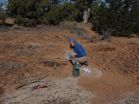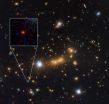(Press-News.org) Researchers at the McCormick School of Engineering are part of a team that has used stretchable electronics to create a multipurpose medical catheter that can both monitor heart functions and perform corrections on heart tissue during surgery.
The device marks the first time stretchable electronics have been applied to a surgical process known as cardiac ablation, a milestone that could lead to simpler surgeries for arrhythmia and other heart conditions. The researchers had previously demonstrated the concept to apply stretchable electronics to heart surgery, but with this research improved the design's functionality to the point that it could be utilized in animal tests.
Researchers utilized stretchable electronics to create a catheter to make cardiac ablation simpler.
A paper describing the research, "Electronic Sensor and Actuator Webs for Large-Area Complex Geometry Cardiac Mapping and Therapy," was published November 12 in the Proceedings of the National Academy of Sciences.
Cardiac ablation is a surgical technique that corrects heart rhythm irregularities by destroying specific heart tissue that triggers irregular heartbeats. The procedure is typically performed either with open-heart surgery or by inserting a series of long, flexible catheters through a vein in the patient's groin and into his heart.
Currently this catheter method requires the use of three different devices, which are inserted into the heart in succession: one to map the heart's signals and detect the problem area, a second to control positions of therapeutic actuators and their contact with the epicardium, and a third to burn the tissue away.
"Our catheter replaces all three devices previously needed for cardiac ablation therapy, making the surgery faster, simpler, and with a lower risk of complication," said Yonggang Huang, Joseph Cummings Professor of Civil and Environmental Engineering and Mechanical Engineering at McCormick.
Central to the design is a section of catheter that is printed with a thin layer of stretchable electronics. The catheter's exterior protects the electronics during its trip through the bloodstream; once inside the heart, the catheter is inflated like a balloon, exposing the electronics to a larger surface area inside the heart.
With the catheter is in place, the individual devices within can perform their specific tasks. A pressure sensor determines the pressure on the heart; an EKG sensor monitors the heart's condition during the procedure; and a temperature sensor controls the temperature so as not to damage surrounding tissue. The temperature can also be controlled during the procedure without removing the catheter.
These devices can deliver critical, high-quality information — such as temperature, mechanical force, and blood flow — to the surgeon in real time, and the system is designed to operate reliably without any changes in properties as the balloon inflates and deflates.
###
Researchers at McCormick led the efforts to design and optimize the system. (McCormick graduate student Shuodao Wang is a co-first author of the paper.) Device fabrications were done at the University of Illinois at Urbana-Champaign, and animal tests were conducted at University of Arizona Sarver Heart Center.
Other partners on this research include Seoul National University in the Republic of Korea; the University of Texas at Austin; Zhejiang University in China; the Harbin Institute of Technology in China; the Institute of High Performance Computing in Singapore; Massachusetts General Hospital; and Tufts University.
Simplifying heart surgery with stretchable electronics devices
Researchers develop catheter that can perform triple-duty during cardiac ablation surgery
2012-11-16
ELSE PRESS RELEASES FROM THIS DATE:
Medical vital-sign monitoring reduced to the size of a postage stamp
2012-11-16
CORVALLIS, Ore. – Electrical engineers at Oregon State University have developed new technology to monitor medical vital signs, with sophisticated sensors so small and cheap they could fit onto a bandage, be manufactured in high volumes and cost less than a quarter.
A patent is being processed for the monitoring system and it's now ready for clinical trials, researchers say. When commercialized, it could be used as a disposable electronic sensor, with many potential applications due to its powerful performance, small size, and low cost.
Heart monitoring is one obvious ...
Video-article shows how to purify magnetic bacteria
2012-11-16
Magnetotactic bacteria, like Magnetospirillum magneticum, have evolved cellular processes that allow them to take up iron molecules to produce magnetic nanocrystals like magnetite. Since they were first discovered and isolated in 1975 by Robert Blakemore, scientists continue to be fascinated by these unique bacteria, whether as a means to isolate biogenic magnetite or to understand the evolutionary advantages of producing these minerals. A new video-article in JoVE (Journal of Visualized Experiments) details a procedure to purify and enrich samples of magnetotactic bacteria ...
Researchers report potential new treatment to stop Alzheimer's disease
2012-11-16
Last March, researchers at UCLA reported the development of a molecular compound called CLR01 that prevented toxic proteins associated with Parkinson's disease from binding together and killing the brain's neurons.
Building on those findings, they have now turned their attention to Alzheimer's disease, which is thought to be caused by a similar toxic aggregation or clumping, but with different proteins, especially amyloid-beta and tau.
And what they've found is encouraging. Using the same compound, which they've dubbed a "molecular tweezer," in a living mouse model ...
WSU scientists find new way for antibiotic resistance to spread
2012-11-16
PULLMAN, Wash.—Washington State University researchers have found an unlikely recipe for antibiotic resistant bacteria: Mix cow dung and soil, and add urine infused with metabolized antibiotic. The urine will kill off normal E. coli in the dung-soil mixture. But antibiotic-resistant E. coli will survive in the soil to recolonize in a cow's gut through pasture, forage or bedding.
"I was surprised at how well this works, but it was not a surprise that it could be happening," says Doug Call, a molecular epidemiologist in WSU's Paul G. Allen School for Global Animal Health. ...
Young gamers offer insight to teaching new physicians robotic surgery
2012-11-16
What can high school and college-age video game enthusiasts teach young surgeons-in-training?
According to a new study from researchers at the University of Texas Medical Branch at Galveston (UTMB) – a world leader in minimally invasive and robotic surgery – the superior hand-eye coordination and hand skills gained from hours of repetitive joystick maneuvers mimic the abilities needed to perform today's most technologically-advanced robotic surgeries.
To offer insight on how best to train future surgeons, the study placed high school and college students head to head ...
Degraded military lands to get ecological boost from CU-led effort
2012-11-16
Some arid lands in the American West degraded by military exercises that date back to General George Patton's Word War II maneuvers in the Mojave Desert should get a boost from an innovative research project led by the University of Colorado Boulder.
Headed up by CU-Boulder Assistant Professor Nichole Barger, the research team is focused on developing methods to restore biological soil crusts -- microbial communities primarily concentrated on soil surfaces critical to decreasing erosion and increasing water retention and soil fertility. Such biological soil crusts, known ...
Hubble helps find candidate for most distant object in the universe yet observed
2012-11-16
By combining the power of the NASA/ESA Hubble Space Telescope, NASA's Spitzer Space Telescope and one of nature's zoom lenses, astronomers have found what is probably the most distant galaxy yet seen in the Universe. The object offers a peek back into a time when the Universe was only 3 percent of its present age of 13.7 billion years.
We see the newly discovered galaxy, named MACS0647-JD, as it was 420 million years after the Big Bang. Its light has travelled for 13.3 billion years to reach Earth, which corresponds to a redshift of approximately 11 [1].
This is the ...
Quick, high-volume test offers fast track in search for Alzheimer's drugs
2012-11-16
An efficient, high-volume technique for testing potential drug treatments for Alzheimer's disease uncovered an organic compound that restored motor function and longevity to fruit flies with the disease, according to new research that could help put the search for an effective Alzheimer's drug on a faster track.
Princeton University researchers report in the Journal of Biological Chemistry that they discovered an organic compound that prevented the formation of protein clumps, or aggregates, found on human brain cells afflicted by Alzheimer's disease. The researchers ...
Neurons made from stem cells drive brain activity after transplantation in laboratory model
2012-11-16
LA JOLLA, Calif., November 15, 2012 – Researchers and patients look forward to the day when stem cells might be used to replace dying brain cells in Alzheimer's disease and other neurodegenerative conditions. Scientists are currently able to make neurons and other brain cells from stem cells, but getting these neurons to properly function when transplanted to the host has proven to be more difficult. Now, researchers at Sanford-Burnham Medical Research Institute (Sanford-Burnham) have found a way to stimulate stem cell-derived neurons to direct cognitive function after ...
Barrow scientists discover ways to optimize light sources for vision
2012-11-16
(Phoenix, AZ Nov. 15, 2012) -- Vision researchers at Barrow Neurological Institute have made a groundbreaking discovery into the optimization of light sources to human vision. By tuning lighting devices to work more efficiently with the human brain the researchers believe billions of dollars in energy costs could be saved.
The research was conducted by Stephen Macknik, PhD, of Barrow's Laboratory of Behavioral Neurophysiology, and Susana Martinez-Conde, PhD, of Barrow's Laboratory of Visual Neuroscience. The study is published Proceedings of the National Academy ...
LAST 30 PRESS RELEASES:
The Journal of Nuclear Medicine Ahead-of-Print Tip Sheet: January 2, 2026
Delayed or absent first dose of measles, mumps, and rubella vaccination
Trends in US preterm birth rates by household income and race and ethnicity
Study identifies potential biomarker linked to progression and brain inflammation in multiple sclerosis
Many mothers in Norway do not show up for postnatal check-ups
Researchers want to find out why quick clay is so unstable
Superradiant spins show teamwork at the quantum scale
Cleveland Clinic Research links tumor bacteria to immunotherapy resistance in head and neck cancer
First Editorial of 2026: Resisting AI slop
Joint ground- and space-based observations reveal Saturn-mass rogue planet
Inheritable genetic variant offers protection against blood cancer risk and progression
Pigs settled Pacific islands alongside early human voyagers
A Coral reef’s daily pulse reshapes microbes in surrounding waters
EAST Tokamak experiments exceed plasma density limit, offering new approach to fusion ignition
Groundbreaking discovery reveals Africa’s oldest cremation pyre and complex ritual practices
First breathing ‘lung-on-chip’ developed using genetically identical cells
How people moved pigs across the Pacific
Interaction of climate change and human activity and its impact on plant diversity in Qinghai-Tibet plateau
From addressing uncertainty to national strategy: an interpretation of Professor Lim Siong Guan’s views
Clinical trials on AI language model use in digestive healthcare
Scientists improve robotic visual–inertial trajectory localization accuracy using cross-modal interaction and selection techniques
Correlation between cancer cachexia and immune-related adverse events in HCC
Human adipose tissue: a new source for functional organoids
Metro lines double as freight highways during off-peak hours, Beijing study shows
Biomedical functions and applications of nanomaterials in tumor diagnosis and treatment: perspectives from ophthalmic oncology
3D imaging unveils how passivation improves perovskite solar cell performance
Enriching framework Al sites in 8-membered rings of Cu-SSZ-39 zeolite to enhance low-temperature ammonia selective catalytic reduction performance
AI-powered RNA drug development: a new frontier in therapeutics
Decoupling the HOR enhancement on PtRu: Dynamically matching interfacial water to reaction coordinates
Sulfur isn’t poisonous when it synergistically acts with phosphine in olefins hydroformylation
[Press-News.org] Simplifying heart surgery with stretchable electronics devicesResearchers develop catheter that can perform triple-duty during cardiac ablation surgery




